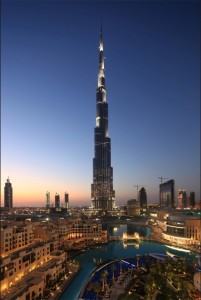By Mohamad Darus www.bernama.com
DUBAI, June 3 (Bernama) — A visit to Dubai is incomplete without a visit to the Burj Khalifa, the tallest building in the world.

The magnificent 160-storey tower, which officially opened to the public on Jan 4, last year, is 828 metres tall. Its construction cost is estimated to be about USD1.5 billion.
The tower’s observation deck, which is at level 124, can be reached via the fastest elevator in the world, with a speed of 10 metres per second.
The observation deck is usually filled with visitors who are eager to enjoy a panoramic view of the largest city in the United Arab Emirates (UAE).
Visitors can witness the modern architecture and fast-paced development of the city, as well as the seas and desert that surround it.
“The Burj Khalifa is the new landmark of Dubai, attracting tourists from all over the world to view the city from the highest level,” said Nor Shaharom Mansor, assistant director at Emaar Properties, the company that manages the Burj Khalifa.
FROM FISHING VILLAGE TO BUSINESS HUB
Dubai used to be a small fishing village on arid land; today, it has transformed itself into a prime tourist and business destination in the Gulf region.
Its main language is Arabic, but English is commonly used in daily transactions, as the city is home to people from various nationalities.
This modern city also boasts an efficient transport network, including a monorail service.
In addition, Dubai has a reputation for being a shopping haven for both general and branded goods. The most popular malls among tourists are the Dubai Mall and the Dubai Outlet Mall.
Another favourite tourist shopping area is Naif Road, which is similar to Jalan Masjid India in Kuala Lumpur. Visitors can find several items, including souvenirs, at the mall at reasonable prices.
The traders are mostly foreigners of Indian, Bangladeshi or Pakistani descent. They sell a wide range of products, from garments, carpets, shoes, watches and mobile phones to electronic products and souvenirs.
ATTRACTING ARAB TOURISTS TO MALAYSIA
Dubai recently held a tourism event called the Arabian Travel Market 2011.
Tourism Minister Datuk Seri Dr Ng Yen Yen headed the Malaysian delegation to the four-day exhibition, which started on May 2 at the Dubai International Convention and Exhibition Centre.
Despite the majesty of the Burj Khalifa and Dubai’s reputation as a shopping haven, Arab visitors eagerly visited the Malaysian pavilion at the Travel Market.
The pavilion, which was built to resemble the structure of a traditional Malay house, was constantly busy with visitors who wanted to learn more about Malaysia as a tourist destination.
The participation of 87 Malaysian government and private agencies at the tourism fair also set a precedent for Indian, Iranian, African and Latin-American tourism markets.
Dr Ng, who acted as Malaysia’s key salesperson, was friendly and affable with Arab visitors.
She also added her personal touch to an appreciation dinner celebrating the tour agencies and airlines in Dubai by acting as host and master of ceremonies for the night.
The main attractions promoted to Middle Eastern travelers were beach and island holidays, shopping, dining and eco-tourism. There were also special promotions for educational and health tourism, honeymoon and spa destinations, as well as the ‘Malaysia, My Second Home’ programme.
Arab tourists were also invited to experience the upcoming Islamic month of fasting, known as “Ramadan” in Malaysia, through the distribution of booklets from Tourism Malaysia.
The booklets are comprehensive guides to accommodation, activities, mosques and venues for breakfast and pre-dawn meals in Malaysia. They also list 67 Middle Eastern restaurants in Malaysia that are near mosques.
TARGETING MORE WEST ASIAN TOURISTS
The Tourism Ministry is targeting around 700,000 tourists from India and 235,000 tourists from various West Asian countries this year.
Last year, Malaysia received 689,000 Indian tourists and 228,668 visitors from West Asia.
“We hope to attract 20,000 more tourists from South Africa annually,” Dr Ng told Bernama.
The total number of tourists who visited Malaysia last year was 24.6 million. This year, the target has been set at 25 million.
The 2010 World Tourism Organization report ranked Malaysia ninth among the world’s most visited countries.
According to Dr Ng, Indian tourists are now interested in holding their wedding celebrations in Malaysia.
“One couple has already booked a wedding ceremony in Malaysia for November this year. They will be spending over USD1.5 million on the celebration, with hundreds of people in their entourage,” she said.
Dr Ng noted that due to political instability in Egypt and Syria, several tourists from Saudi Arabia are also turning to Malaysia as a holiday destination.
“We will also continue promoting Malaysia in Saudi Arabian cities, such as Jeddah, Riyad, Dammam, Al-Khobar and Dhahran,” she added.
AIRLINES PROMOTING TO ARAB TOURISTS
During a meeting with Sheikh Ahmed Saeed Al Maktoum, the Chairman of Emirates Airlines, Dr Ng was informed of the airline’s willingness to fly Latin American tourists to Malaysia.
The airline is one of the largest in the world and currently has routes from Dubai to Sao Paolo in Brazil.
Emirates Holidays, a subsidiary of Emirates Airlines, is also looking into the possibility of including Malaysia as one of its “must-visit” destinations in its tourism packages.
“It has opened up new and dynamic tourism business opportunities for us,” said Abdul Hamid Ahmad Maulana, the General Manager (Corporate Sales and Marketing) of Puteri Hotels Sdn Bhd.
Meanwhile, Datuk Azman Umar, the Langkawi Development Board General Manager, said the tourism fair was the best platform to promote the exciting tourist attractions of Langkawi and the rest of Malaysia to Arabs, Europeans and Latin Americans.












